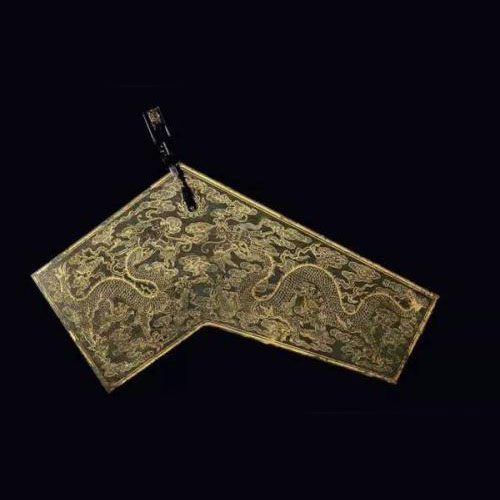qing overview
 Qing (pinyin: qìng) is an ancient Chinese Han stone percussion instrument and ritual vessel. The left half of the chime character in the ancient Chinese script resembles a hanging stone, and the right half resembles a hand struck with a mallet. The chime originated from a kind of flaky stone labor tool, and its shape has changed in many ways, and the texture has also changed from the original stone to jade and copper chimes. Play the body music instrument. The ancient Chinese stone percussion instruments are the "stone" sound in the "eight-tone".
Qing (pinyin: qìng) is an ancient Chinese Han stone percussion instrument and ritual vessel. The left half of the chime character in the ancient Chinese script resembles a hanging stone, and the right half resembles a hand struck with a mallet. The chime originated from a kind of flaky stone labor tool, and its shape has changed in many ways, and the texture has also changed from the original stone to jade and copper chimes. Play the body music instrument. The ancient Chinese stone percussion instruments are the "stone" sound in the "eight-tone".The chime was first used in music and dance activities in ancient China, and later used for the banquets in the palaces of emperors and upper-level rulers, sacrifices in ancestral temples, and band performances in court engagement ceremonies. After the Tang and Song dynasties, new music emerged, and the chime was only used for the Yale band in sacrificial ceremonies.
According to the place of use and the way of playing, chimes can be divided into two types: special chimes and braided chimes: special chimes are musical instruments played by the emperor when offering sacrifices to heaven, earth and ancestors; braided chimes are made up of several chimes and played on a wooden stand. in court music. During the Warring States Period more than 2,000 years ago, the craftsmanship of Chu's weaving reached a high level.
The chime is the oldest national musical instrument in China. It is simple in shape and exquisite in production. The history of chime is very long. In the ancient matriarchal clan society, chime was once called "stone" and "singing ball". At that time, people lived by fishing and hunting. After labor, they tapped stones and danced for entertainment in the image of various beasts. This kind of percussion stone was gradually evolved into the later percussion instrument.
There are many types of "chimes", including "jade chimes, iron chimes, copper chimes, braided chimes, Sheng chimes, song chimes, song chimes, and special chimes". Each kind of chime is roughly composed of one to sixteen pieces of stone or iron. It is due to the use of the difference in length and thickness of stone or iron pieces to produce different rhythms.
The ancient chimes are divided into: weaving chimes, cloud chimes and special chimes
- Pinyin:qìng
- type:percussion
- material:Jade, copper and stone
overview of other similar instruments
- sanyanxiao overview
- Daguangxian overview
- Leiqin overview
- hahao overview
- yandundagu overview
- Han Xiaozheng overview
- Fang Xiang overview
- guanzi overview
- zhuqin (Dao Qin) overview
- zhuiqin overview
- bangzi overview
- three-stringed piano overview
- Gehu overview
- xiao overview
- xiaokonghou overview
- Konghou overview
- Sheng overview
- suona overview
- hulusi overview
- gushao overview
 渝公网安备 50010702504639号
渝公网安备 50010702504639号